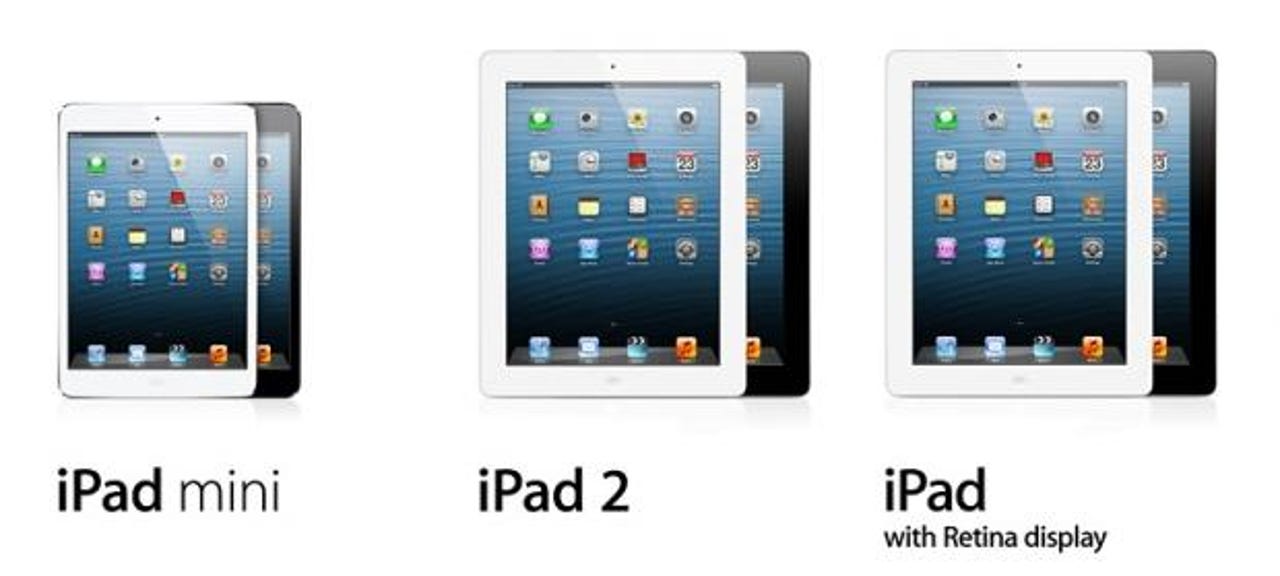Apple's iPad mini pricing: Did it miss the tablet death blow?


Apple's move to price the iPad mini at a starting price of $329 may preserve profit margins, but ultimately may cede some of the tablet market to the likes of Amazon and Google's Android army.
The $329 price tag was viewed as a negative development among a few analysts and tech observers on Twitter. Indeed, the $329 price for the iPad mini is tricky and appears to be designed to ensure iPad 2 sales are cannibalized instead of the latest version of the popular tablet.
Analysts were mixed on the iPad mini pricing. The general theme is that the iPad mini expands the total addressable market for Apple and strengthens its hammerlock on the tablet category. However, Apple could have delivered a death blow with a $299 price. Despite all the bluster about Google's Nexus 7, the price difference between the Android tablet and iPad mini makes the comparisons tricky.
More: Apple's iPad mini: it's all about price elasticity | With new iPads, Apple targets education opportunity | Google and Amazon can breathe a sigh of relief as Apple skips competing on price with iPad mini | Apple gets official with iPad mini; upgrades iPad again | Apple statement
Wall Street analysts made the following moves:
- First, iPad shipment estimates for the current quarter were cut.
- Many analysts said that refreshing the latest iPad so soon would alienate customers.
- And many expect the iPad mini to sell well.
What remains to be seen is whether Apple bet on a price tag of $329 for the iPad mini when it could have priced it at $299 and nailed the market. Morningstar analyst Brian Colello sums it up:
We're a bit disappointed at the starting price point of $329, as we fear that price-sensitive consumers may continue to turn to alternative tablet solutions, such as Amazon's Kindle Fire and Google's Nexus tablet at $200 price points...Apple could have strengthened its narrow economic moat by bringing more customers onto the iOS platform, as we believe that iOS customers who own multiple Apple products face higher switching costs and are less likely to shift to alternative platforms. Instead, the opposite scenario may play out. The risk around the mini, in our view, is that Apple's Mini pricing may concede more of the low-end tablet market to Amazon and Google, running the risk that these Android tablet users may buy compatible Android phones and/or shy away from Apple iPhones in the future.
Other Wall Street analysts were worried about the iPad mini price, but not by much. Piper Jaffray analyst Gene Munster said he thought consumer demand would still be strong.
Barclays analyst Ben Reitzes said in a research note:
We were hoping the mini could be priced at least a little lower given its competition is situated as low as $99, with many starting in the $199-$249 range. That being said, Apple seems convinced that consumers want the iPad and its ecosystem, which has worked so far at the high-end. We believe Apple can sell 5-10 million iPad mini’s in the December quarter while cannibalization of the other iPads will likely run at 25-50%.
In the big picture, Apple, which is built to sell hardware at a premium, went with profit margins over worrying about the low end of the market. Time will tell if Apple missed a death blow, but with 100 million iPads sold the company can afford to take a few chances.